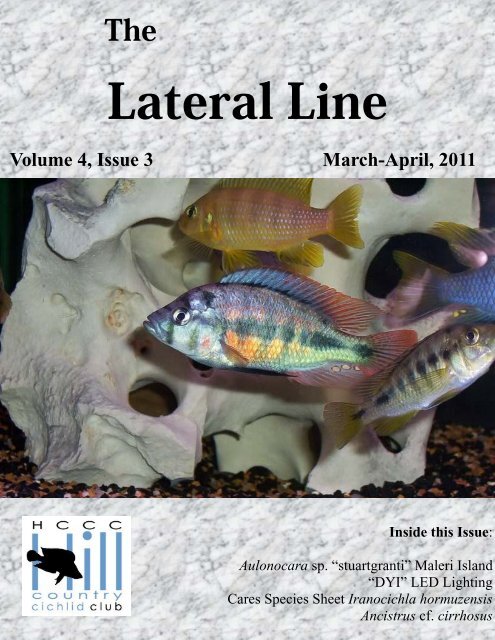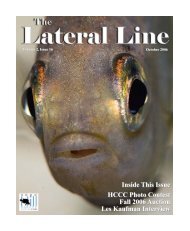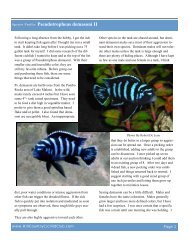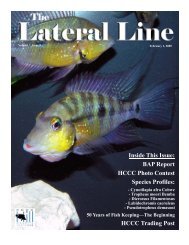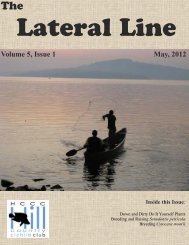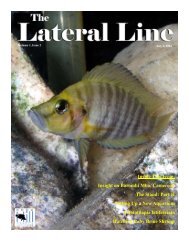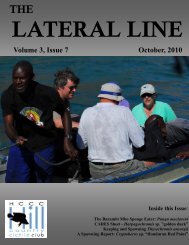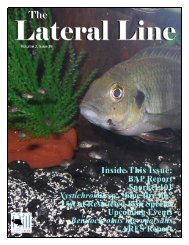Lateral Line March 2011 - Hill Country Cichlid Club
Lateral Line March 2011 - Hill Country Cichlid Club
Lateral Line March 2011 - Hill Country Cichlid Club
- No tags were found...
You also want an ePaper? Increase the reach of your titles
YUMPU automatically turns print PDFs into web optimized ePapers that Google loves.
2The HCCC is a proud member ofthe Federation of TexasAquarium Societies.The HCCC is a proud member ofthe Federationof American AquariumSocieties.Contents:Cares Species Sheet Iranocichla hormuzensis 3Fish Rooms: Managing the CostChapter 3: Lighting - Making LED affordable- Dan Schacht 4Do You Know? Aulonocara sp. “stuartgranti Maleri” (Maleri Island)- Kory Watkins 16My experience with Ancistrus cf. cirrhosus- Walter Wooton Jr. 24Spring has sprung in South Texas. Unfortunatelywe have had a lack of rain which willsurly affect the annual wild flowers. I haven’tseen a single blue bonnet yet.The fish have started getting spring feverthough and some great spawns are in theworks. I hope the rest of you HCCCer’s areexperiencing the same thing.In April we will head on up to Austin for theannual Amazonia cichlid Symposium. Thisyears speakers are Dave Hansen, WalterWooton and Caroline Estes. This is going tobe a great event! Next up will be the ACAin Washington DC. Looks like we’ll havegood representation from the club. Hey,what about that auction? Great crowd, gooddeals and lots of super fish, plants andequipment! I’m not sure when the next auctionwill be but certainly by September we’llput another on.FOTAS CARES is coming up fast! There’sstill lots of work to do. The facility is incredible.I’m really looking forward to this.This issue of the <strong>Lateral</strong> <strong>Line</strong> is going to bewell read. Walt gives us the benefit of someof the tricks he employs to breed bristlenoseplecos. Kory Watkins writes a breeding accounton Aulonocara sp. “stuartgrantiMaleri”. It’s been a while since I’veworked with peacocks and this is one I’venever tried. We continue highlighting a CA-RES species in each issue. This month isIranocichla hormuzensis. I would absolutelylove to work with that fish!The talk in the club as of late, has been LEDlighting. Dan relates cost comparisons betweenrunning LED’s against other types oflighting.. He then explains how to acquire,and assemble LED’s.The BAP is coming to life lately too. Therehas been a huge resurgence in reports andnew entrants scoring some big points. Therace for Breeder of the Year is certain to beworth watching. Benjamin set the bar highlast year. Will anyone be able to top his singleyear point total?
4Fish Rooms: Managing the CostChapter 3: Lighting - Making LED affordable- Dan SchachtThis aquarium full of lush live plants is lit solely by LED lighting. Photo by David Fair.As I write this I am reminded of one of myfavorite authors. He is publishing a series ofnovels that I enjoy so very much. As he iswriting book 5, the next book due out, forsome reason the publication date just keepson moving further and further into the future.He is now a good year and a half lateand there is not even a glimmer as to whenthe novel will be released. Finally, as I finishwriting an article that I have promised torelease for 5 months, I think I understand. Ihope you enjoy it and that it is worth thewait.For everything there is a budget and everythinghas a budget, even if we don’t knowthat it has a budget. Our beloved fish are noexception to the budget rule. Many of us,myself included have had to scale back thefish room and expenses as the recession hasdragged on for what seems like an eternity. Iam introducing a series of 7 articles that Iplan on writing over the next few years. Youwill have to bear with me as each and everychapter requires research, experimentation,and practice. We as cichlid keepers have anever increasing need to manage the costsassociated with raising our fish. As we growthe number of aquariums in our care, the increasedcost of not only the fish and the foodmater, but also the monthly support coststhat waste away our household budgets matteras well. In each installment I will discussthe areas that I have identified in whichmanagement of costs matter the most. Thearticles will follow the following topics, butnot necessarily in order.1. Space2. Water3. Lighting4. Heating5. Filters6. Air System7. Foods & ChemicalsDue to popular demand, I have selected item
5#3 for this article. Lighting is the 3rd largestcost in my fish room and as such it raisestwo primary concerns. The first is the capitalinstallation cost and the second is themonthly electrical bill. The age old questionarises, “If you had $1000 and you couldspend it however you choose, what wouldyou buy?” It is a good thing that I don’t have$1000 to spend, as I would have one ofthose new fancy LED HD TVs sitting in myliving room if I did. The upfront “capital”cost of lighting falls into this category.Would your $1000 go into replacing yourfish room lighting? This upfront cost is theprimary reason that LED lighting has notgained a stronger foothold inside of theUnited States.The largest problem that exists with LEDlighting is the capital cost. Retailers andmanufactures are marketing the products atsuch high margins that it is cost prohibitivefor the average Joe cichlid keeper with about20 aquariums to upgrade his lights. The onlypeople that can even scratch the surface ofLED lighting are those that have only one ortwo aquariums. The rest of us are just left inthe dark (well, not literally in the dark, westill have our fluorescents…).In aquaria there are many systems of lighting.I am analyzing only three. Of the threesystems of lighting, two are my own DIYhome creations, and as such are designedwith my needs in mind. The third system is asystem commonly found in aquaria installations.Today we look at the three installations:1. The Shop Light2. The Compact Florescent3. The LED LightThe Shop Light is by far the most commonlighting system in use today. Although nowas wide spread, many people around theUnited States have started using a CFL(Compact Florescent Light) design installedin their fish rooms as well. The primary purposeof a CFL design is to “save space”above the tanks. This is a concern because,although strip lights are cheaper, they takeup 3” of space above an aquarium and get inthe way when performing maintenance. In arack situation the space saving design wascritical and my primary purpose in designingthe light installations #2 and #3.My Test Setup:In all of my experiments, I am using a threetiered rack design. My test design will housesix 20 Breeder aquariums. The 20 breeder isan uncommonly sized aquarium with nearideal dimensions. The dimensions on the 20breeder are approximately 24” long, 18”wide, and 12” deep. This is great for juvenilesand fry grow out, and can even housepairs of fish that are not overly aggressive. Istacked the tanks so that I will have 10” ofclearance between the top of an aquariumand the bottom of the next shelf. Twoaquariums are going to be installed on eachshelf, making the entire setup 80” from thefloor to the top of the top aquarium. Thisheight was chosen because I can feed thefish in the top aquarium without a stool, ladderor chair as it is just within reach.In the below sections, I outline the type ofinstallation, the impact the installation hason “space” above the aquarium (how muchit eats into the 10” of clearance I left in therack), the impact of upfront costs, and themonthly maintenance cost of the setup. Inconclusion, I will summarize the cost ofownership by year for the first 5 years andany thoughts and opinions that I have on thesubject.I wish to make it clear now, that my homemade designs are not “approved” for use
7much, but 3 inches of space on a single layeraids in the removal of rocks and decorations,the catching of fish and maneuvering ofnets, and in the removal of hang on the backfilters for maintenance. This one disadvantageis why I ruled out the shop light as myprimary fish room light.Compact Florescent Light (CFL):In an attempt to install a light fixture thatresides 100% within the 2x4 frame of myracking system, I devised the installation ofcompact fluorescents. There are a plethoraof choices when selecting the CFL. Themost common CFL is the twist lampthat most of us use in our homes. Ichose not to use the twist in style CFLlamps, but rather a pin based plug inlamp with a GU24 base. This designwas intended to simplify the eventualupgrade of the lamps to LED lampswhich commonly come in the GU24base. At the time I had not discoveredan affordable supply of LED lamps,but I knew that one day I would findone.After a careful selection, I selected aballast and CFL that would work formy situation. The selection was primarilybased on cost. I found that theballasts are so expensive that theydwarf the cost of the rest of the fixture.While searching, I looked for something thatis less than 3 ½ inches tall AND less than 14inches long. The length was important becauseif the lamp were longer, I would notbe able to install or replace it inside the rack.The selected lamp is 1½ inches tall and 8inches long and I found affordable ballaststhat can operate two of the selected lampseach.After much research, I assembled a materiallist and started to order. As I practiced installingI discovered that the installation ofthis design is not simple or easy. It took mea good 2 hours of trial and error research todiscover how to properly wire the ballast tothe lamps. The ballast came with 9 differentwiring methods and only one of the 9worked. In Table 2 is a list of what I ordered.These were the best prices I couldfind anywhere I looked, both locally andonline. As I build the lights I continued toimprove on the design. As can be seen in thephotos, I do not have the Stainless Steel foilas a grounding base behind the lamps as Iadded that to the design as a later date.The ballast was purchased from1000bulbs.com which is based in Garland,Texas. The part number is “BF-WH2120CC”. I also purchased my CFLlamps from the same company. The catalognumber for the CFL lamps is “FC13-G24Q141OD”. I ordered the lamp base fromLightBulbEmporium.com, the same place Iordered the LED lamp bases. The CFL lampbase is similar to that of the LED’s, but it isa little different. The part number for thebase is “90-1549”. Many of the smaller
9The schematic used to wire LED lighting.Top of Rack Lights –All Safety Features IncludedClose up of Rack Light –All Safety Features IncludedFuse Holder Box – The fuse holder has a0.5 Amp fuse and is supplying 4 lightsCorner of installation with light switches
10All Lights OnLeft Light Only OnRight Light Only OnUnderside corner close up – Lights offAngled view above of rack lights – Lights onClose up of the wiring
11even get what I ordered, or that what I orderedwould even work. I then noticed a linkto a smaller website that was owned by thesame parent company. This is where I foundan order for a lot of 30 lamps for almost aslow of a price. I was much more willing torisk $300 than I was willing to risk $1000.The lamp I selected for my trials was purchasedfrom www.aliexpress.com. This is awhole sale site that targets the smaller customer.I have successfully made a purchasefrom this website and I will purchase fromthem again. (I warn you that you are offeringyour e-mail address to China and you WILLsee an increase of spam messages.) Whensearching I searched for “LED GU24 SMD5W”. This is the SMD style LED with aGU24 base and a 5 Watt power rating. I alsoselected the filter for a shipping method of“Free Shipping to the United States”. Bewary of the high shipping cost of some ofthe vendors on the site (much like eBay).You should be able to find the lamps (lamponly) with free shipping for about $10 eachif you purchase lots of 20-30 at a time.The base needed is a G24D-3 base which Iobtained from LightBulbEmporium.com for$1.14 each. On the LightBulbEmplorium.comwebsite, you can enter“clearance” in the coupon code section toreceive free shipping on all orders of $8.00or more. Search for part number “90-1548”and you will find a G24D- 3 base. The remainingitems were purchased from amazon.com,eBay, Home Depot, and RadioShack. I trust that anyone searching for theseitems can find them somewhere with a littleeffort. For the compete list of material orderedreference Table 5.
12As part of the safety feature, I am installingone fuse per level per rack. This means thatin some racks I will fuse the circuit for 4lamps (fewest) and on others I will fuse thecircuit for 9 lamps (most). Fuse sizes neededfor my installation are ¼ amp fuses (up to 5lamps) and ½ amp fuses (up to 10 lamps).Try to load fuses to about 80% of the fuserating to reduce blown fuses, but keep thefuse rating as low as possible for safety.When calculating the energy costs of theLED lamp, I was able to use four 5 Wattlamps for a total of 20 Watts. This comparesto the shop light power consumption of 66Watts and the CFL consumption of 56Watts. We finally found a way to reduce themonthly maintenance cost of the lighting.I was pleasantly surprised how affordablethe LED lights are compared to the CFL fixture.The LED fixture actually costs less,puts out more light (see section on testing),and uses less energy. Wow, can you say wehave a winner? I sure can. Although theLED has clear advantages, to be fair, I mustrecognize the disadvantages that the LEDfixture has as well. For a complete list ofadvantages and disadvantages, please referto Table 6.The LED/CFL Installation:The great thing about the LED lamp chosenis that it does not require a ballast to operate.The connection is directly to the 120 voltwall outlet. Concerns that arose in the installationis that to maintain a semblance of followinglocal and national codes, you have toinstall a #14 or #12 AWG copper wirethroughout the entire installation. The lampbase is such that it only accepts a #18 AWGsolid copper wire. The only way I could deviseto reduce the wire size and still protectthe wire from over current conditions is toinstall the in-line fuse. This limits the currentto 5 amps and below (5 amps is thehighest the in-line fuse holder I purchasedcan go) which is under the rating of #18 wire(rated for up to 10 amps).The fuse alone does not remove the hazardto your safety. Even ½ and amp can kill youif there is a low resistance path through yourbody (aka. You are wet). To reduce this risk,I recommended a GFCI protected outlet asyour power source. In fact, every outlet youuse in your fish room should be protected byGFCI outlets or breakers. To help a GFCIwork properly, the GFCI will need to have aproper ground. The ideal solution would beto ground the rack frame, but if your rack is
13rack frame, but if your rack is like mine,then you are up a creek. Wood is not a goodgrounding conductor.As a backup solution, I thought to install astainless steel foil sheet behind all of mylights. I need to ensure that I am touchingthe Stainless steel sheet whenever I amworking with the electricity in the fish room.Doing do will ensure that if I get shocked, Iwill probably not be killed. I selectedStainless steel foil for 2 reasons. (1) it doesn’trust and (2) aluminum was not a goodoption because it reacts in humid environmentswith copper and I am using copperwire.For other instructions on how to build thelight fixture, I recommend trial and error andlook at the pictures. It will be for me to explainever little thing that needs to be donewhen building the lights. I figured that thebest I can do is take pictures of the installationfrom every angle and let you figure itout for yourselves.The Testing:In an attempt to be as scientific and unbiasedas possible, I borrowed a light meter fromwork. I placed the light meter at ten inch intervalsdown the length of the rack. I placeda white reflector underneath the test meterand another white reflector on the shelfabove the test rack. The readings were takensix inches from the front of the rack and sixinches from the back of the rack. Figure 4displays the test locations while comparingthe three lighting systems. The measurementswere taken after each light had fiveminutes to warm up and with all other roomlights off.The test results are displayed in Table 7. Allunits of measurements are in Foot-Candles,a standard measuring unit for light levels.The T8 light fixture had by far the highestoutput light level of the 3 systems, but it alsohas the highest power input. The T8 lampswere also 3½ inches closer to the light meterbecause they intrude into the clearance spacebetween the rack and the aquarium. In acomparison of light per watt of electricity,the clear winner is the LED light fixture. Toincrease the light level, additional LEDlamps can be installed if desired.Cost of Ownership Analysis:As part of the cost of ownership I must includethe following items:1. Capital Installation Cost (100% in thefirst year)2. Monthly Electricity Cost3. Lamp Replacement CostCFL lamps have an average life of 10,000hours. This means that they will require replacementevery 4 ½ years. In comparison,the T8 florescent lamps have an average lifeof 25,000 years and will only need to be replacedevery 11.5 years. The LED lamps
14The LED lamps have a life of 50,000 hoursand should not need replacement but onceevery 23 years.The electricity usage from Figures 1, 2, and3 above convert into the annual energy usagenumbers found in Table 8.The true cost of ownership is displayed inTable 9. In Table 9, the installation cost andone year of electricity is summed in the firstyear. In the second and subsequent years,only the additional cost of electricity isadded into the previous year. In year 5 forthe CFL, the cost of 4 replacement lamps isincluded.Conclusion:In part to manage my costs, and in part tokeep my wife happy, I am in the process ofbuilding a new fish room. I have removed allof my aquariums from inside the house andrelocated them to my “hobby room” whichis built onto the side of the garage. In all itsglory, my original fish room (100% insidethe house) consisted of 32 aquariums andover 1200 gallons of water. At the moment Iam only running eight aquariums at only 350gallons of water while I finish constructionof my fish cave. As I expand the fish cave Iam replacing and installing the LED lightson all aquariums. When I finish building thefish room I will have 45 aquariums with acapacity of 1500+ gallons of water. I willhave over 120 of the LED lamps installedthroughout the room, and will be paying ameasly $6.50 (only ½ on at a time unlessphotographing or showing the room) amonth for my lighting. The room is beingbuilt to optimize all the costs outlined in theintroduction of this article. As I progress,additional articles will be written to expoundon my findings in other areas.I hope you find the information objectiveand informative as it helps you decide howto manage your ever increasing costs.It will take just over four years to see anyreturn on investment for installing LEDlights. These numbers only hold true if youwere to purchase the shop light fixtures. Ifyou already own the shop light fixtures, andyou were to purchase the LED lamps as areplacement, it would take an additional twoyears (six total years) to realize a return onyour investment.
16Do you know? Aulonocara sp. "stuartgranti Maleri" (Maleri Island)-Kory WatkinsA beautiful male Aulonocara sp. “stuartgranti Maleri” in the aquarium of the author.I bet many of you have heard someone saythat they have a Sunshine Peacock. Most areprobably correct. However I would also betthat some of the time, they in fact, have beenmisguided. There are a few different speciesof peacocks that are referred to as the“sunshine peacock.” There are many beautifulAulonocara species from Lake Malawibut the true Sunshine Peacock is eye candy.The Aulonocara sp. "stuartgrantiMaleri" (Maleri Island) is an extremely attractivepeacock from Lake Malawi in Africa.When growing up, males and femalesare pretty much identical and can not besexed on sight. If you have several differentbreeding species of Peacock it is a must toseparate the fry. At 2-3 inches the males willstart to mature and the first tinges of colorstart to appear. Females will always retainthe same dull color with faded vertical lines.Once the males are fully grown they willdisplay a bright blue and yellow color thatwill make you gape for days.At present, the species is included in the A.stuartgranti complex by virtue of its similarbehavior and body shape. It is separatedfrom others in the complex as it appears toform an isolated population in the lake, suggestingit is a distinct species. There are severalgeographical variants available, as wellas a couple of man-made forms that exhibita deep orange/red colorations. It should benoted that neither these, nor any other speciesor morph of Aulonocara should bemixed in the aquarium. Females of the variousspecies are almost identical and theymay hybridize. Please make sure you arecertain which species you are working with.The "stuartgranti Maleri" has not yet beendescribed to science but is everywhere in thehobby. The appearance in color and patternis very close to an Aulonocara baenschi. It isvery often referred to as a “Sunshine” or“Yellow Peacock”. If you compare thesnouts of the two they can be told apart. InA. baenschi, the profile of the snout contin-
17Aulonocara sp. “stuartgranti” Maleri Island in the aquarium. Photo by the author.
18ues in a convex curve over the eye. In A. sp."stuartgranti maleri", this line is muchstraighter. Knowing this is very important.You do not want to get two different speciesand think you have the same thing. Youcould come out with hybrids which isfrowned upon in the hobby.Konings (1995c: 198) provides the followingbehavioral notes in the wild:All forms of the stuartgranti group behavein a similar manner. They are rathercommon in the intermediate habitatwhere females and juveniles are found insmall groups (or singly) feeding from thesandy patches between the rocks. Theyare most numerous on gently slopingcoasts where many rocks lie scattered onthe sandy floor. Males excavate nests betweenrocks and territories are markedwith a shallow rim of sand at the entranceof the spawning-cave. Digging is rarelyobserved in Aulonocara, although malesof several species have tunnel-nests betweenstones.I myself have a group of A. sp. "stuartgrantiMaleri" that consists of two males and eightfemales. The group is in a standard 55 gallonaquarium with a group of Cynotilapia Axelrodifrom Nkhata Bay. The tank has twosponge filters rated for 40 gallons each. Formy substrate I use pool filter sand that youcan get at the Home Depot costing six bucksfor 50 pounds. In addition to the pool filtersand I also use some breeding caves and afew pieces of Texas Holey Rock. The breedingis non stop and the temperament level isvery calm. Out of the 20 plus aquariums thatI maintain, this is by far my favorite one.If you are into <strong>Cichlid</strong>s and wanting to trysomething with a striking yellow and bluecolor, you might want to look at getting Aulonocarasp. "stuartgranti Maleri" (MaleriIsland) . When doing so remember to go to areliable and knowledge source when shoppingfor this species or any species of peacock.I recommend Dave’s Rare AquariumFish. Great selection and the species are alwayspure. There are a handful of peacocksthat are similar to others so we as hobbyistmust make sure we are getting the correctspecies that way there is no risk of crossingour fish.After reading this short article I hope youhave learned and few things about theMaleri Island peacock and how it differsfrom the other close species of peacocks.Finally please remember to get you Peacocksor any species of fish from a good reliablesource!ReferencesKonings, Ad. 1995. Malawi <strong>Cichlid</strong>s inTheir Natural Habitat (Second edition).<strong>Cichlid</strong> Press.Fishandtips.com http://fishandtips.com/displaydb.php?ID=39USAFishBox.com http://usafishbox.forumotion.com/t5-aulonocarasp-stuartgranti-maleri-island?highlight=aulonocara+sp+++stuartgrantiThe female Aulonocara sp. “stuartgranti”.
20HCCC Leadership GroupRobert De LeonDave HansenJB EdmundsonDiane TennisonDan SchachtEvan BowersGreg SteevesHCCC WebmasterRobert DeLeonHCCC Database GuruEvan BowersHCCC TreasurerDave HansenHCCC MembershipDiane TennisonHCCC LibrarianTakeru Garcia (Austin)Walter Wooton (San Antonio)HCCC <strong>Lateral</strong> <strong>Line</strong> EditorGreg SteevesHCCC BAP ChairmanDan SchachtHCCC CARES ChairmanTroy VeltropHCCC CARES/InternationalCARES CommitteeClaudia DickinsonDave HansenBarbara WootonTroy VeltropGreg SteevesBox Exchange CommitteeDave SchumacherMarc GarciaHCCC Honorary Life MembersSpencer Jack 2004Robert De Leon 2006Anton Lamboj 2007Dave Hansen 2007The HCCC Would like to thank thefollowing club supporters. Withoutyou, we wouldn’t be what we are!Omega SeaAquatekLisa’s Lair BookstoreDave’s Rare Aquarium Fish<strong>Cichlid</strong> PressSan Francisco Bay BrandZoomedCentral AquaticsPetfrontierLeslies Pool SupplyDarby’s Tropical FishFish Hobby SupplyUSA Fish BoxAmazonia International<strong>Cichlid</strong> NewsGinger ProductsAquadome
23Schedule of EventsApril 9Amazonia International’s Annual<strong>Cichlid</strong> SymposiumSpeakers:Walter Wooton Jr.– Comal River NativesDave Hansen - TilapinesCaroline Estes - <strong>Cichlid</strong>s for any sized TankBegins at noon, Admission is freeBring a chair. Austin, TX.MayEvent TBDJuneEvent TBDJulyHCCC MeetingAt the Capital of Texas ZooAustin TX.Speaker Michael HicksAugustEvent TBDSeptemberHCCC AuctionScherts TX. (tent.)OctoberEvent TBDNovember 4th - 6thFOTAS CARESSan Antonio TX
24My experience with Ancistrus cf. cirrhosus- Walter Wooton Jr.A male Ancistrus cf. cirrhosus on his spawning cave with fry. Photos by the author.Ancistrus cf. cirrhosus, locally known as thebristlenose, is a wonderful little addition tojust about any tropical tank. I have these little"algae eaters" in almost all my tanks savethose that have other species of "plecos" ortanks with hyper-aggressive species. The phof these tanks range from 6.7 to 8.2, watertemps from 68F to 81F (20C -27.2C)planted, to bare bottom and they all seem tosuffer no ill effects from the different tanksetups; instead they seem to thrive in each.The size of these makes them a much better"pleco" to be sold in fish stores since theystay under 5 inches (12.5 cm) instead ofgrowing to 13+ inches (35+ cm) like thePterygoplichthys pardalis which is generallysold in pet stores. Feeding is quite simplesince they will eat just about anything thatyou give them, but a vegetable based diet isbest. I feed mine some algae wafers eachevening after turning out the lights and somezucchini once a week, along with maintaininga piece of wood in the tank to help withdigestion. In my planted tanks they leave thehealthy plants alone while keeping theleaves free of algae, even my MadagascarLace (Aponogeton madagascariensis) is notdamaged by them. Mixing these in a communitytank is quite simple since they arequite gentle and seem to never quarrel with
25Multiple generations of bristlenose in the same aquarium.any other species including other bottomfeeders. They will fight amongst themselvesover a cave or hide and other than that theyseem to claim no territory.Sexing and breeding is quite simple. Maleswill get soft fleshy growths on their nosethat reminds me of "Velcro" and femaleswill be mostly smooth, but may have somegrowth but it will be much shorter then amales and not as many. To breed them it isalmost as easy as getting a mature male andfemale and throwing them in a tank with acave, but not quite. It is best to prep bothyour male and females before breeding byfeeding a diet of fresh vegetables and a littlebit of a meaty food. Caution - too muchmeat will cause bloat which may causeyour fish to die. I believe this diet helps thefemale in her egg production and the male tobuild up a energy reserve that he will usewhile incubating and protecting the eggs andfry. I seem to be able to stimulate breedingby doing a 75% water change with moresuccess if I cantime it with a coldfront movingthrough the area.To breed, the malewill get the femaleinto the cavewhere she will laythe eggs and themale will fertilizethem, then fanthem with his tail.It doesn't take longfor the eggs tohatch I seem tohave a new batchof free swimmingfry every otherweek in my breedingtank.Once the fry arefree swimming the male is ready to breedagain. Bristlenose don't seem to be pickyabout what they call a "cave" so as-long-asthey can squeeze into it and feel safe theycan call it home, this seems to apply more tothe males as they are home body's while thefemales seem to roam more. Caution -make sure all aquarium decorations havesufficient room for them to get in and outsince they are not very flexible. While it ispossible to have breeding in a communitytank, the mortality rate of fry can be veryhigh due to predation. A separate tank is recommendedif breeding is the main goal. Ifthe goal is to use them as part of your algaecontrol program they readily mix with justabout any species in all but the smallest oftanks as-long-as you give them plenty ofhiding places and provide a steady diet ofveggie based food. Go ahead, give them atry, you won't be disappointed.
26The <strong>Lateral</strong> <strong>Line</strong> is the official publication of the <strong>Hill</strong><strong>Country</strong> <strong>Cichlid</strong> <strong>Club</strong>. Reprinting permitted to noncommercial organizations.


